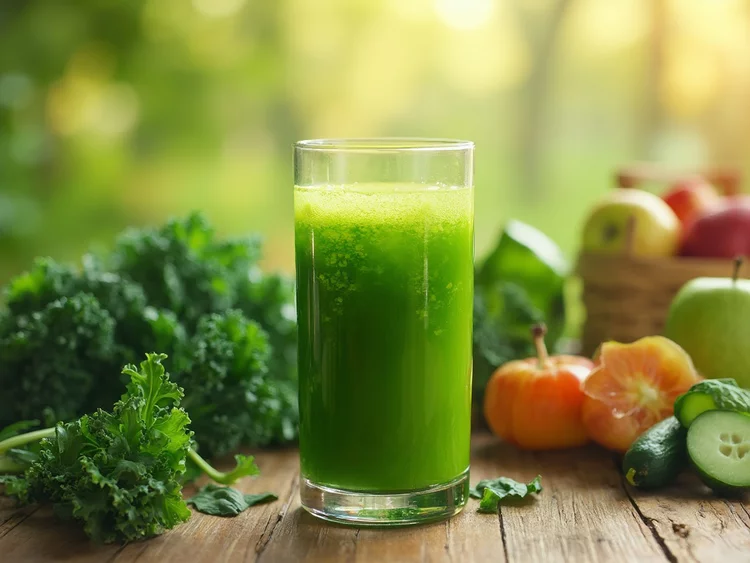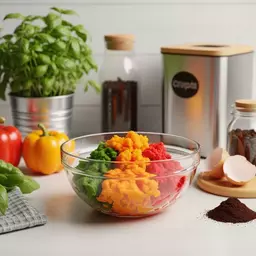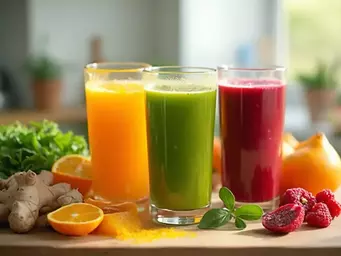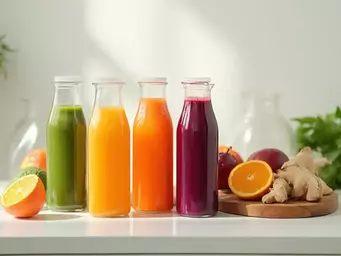Every glass of juice we sip can be a step toward a healthier planet. Consider this: by embracing sustainable juicing practices, we not only enhance our health but also contribute to environmental conservation. Are you ready to transform your juicing habits for the better?
What You Will Learn
- Understanding the principles of sustainable juicing and its environmental benefits.
- How to minimize waste by reusing juice pulp and choosing local produce.
- The importance of supporting local economies through sustainable agriculture.
- Effective strategies for reducing food waste in your juicing practices.
- Ways to engage with your community to promote sustainable juicing initiatives.
The Environmental Impact of Sustainable Juicing
Sustainable juicing offers significant benefits for our planet and communities. This visual highlights the key areas where conscious juicing practices make a difference.
Reducing Packaging Waste
- Buy in bulk to cut down on plastic.
- Use reusable containers for juices.
- Grow your own produce.
Lowering Carbon Footprint
- Choose local, organic ingredients.
- Reduce transportation emissions.
- Support local farmer’s markets.
Supporting Biodiversity
- Organic farms encourage crop diversity.
- Protect pollinators (e.g., bees).
- Contribute to healthier ecosystems.
Food Waste Reduction
- Utilize juice pulp in recipes.
- Plan juicing to avoid spoilage.
- Compost leftover scraps.
Understanding Sustainable Juicing and Its Role in Environmental Conservation
At The Juicing Hub, we believe that juicing goes beyond just health benefits; it’s about embracing sustainable practices that positively impact our planet. Sustainable juicing is a way of consuming fresh juice while being mindful of our environmental footprint. But what does it truly mean to engage in sustainable juicing? Let’s break it down!
What Defines Sustainable Juicing?
Sustainable juicing involves choosing ingredients and methods that protect our environment while providing delicious, nutritious juice. This means prioritizing organic produce, minimizing waste, and reducing energy consumption throughout the juicing process. By making conscious choices, we can transform our juice habits into powerful tools for environmental conservation. For more detailed insights into the broader impact of sustainable food systems, you can explore research on sustainable food systems.
Exploring the Principles of Eco-Friendly Practices
When we talk about sustainable juicing, several eco-friendly principles come into play:
- Use of organic fruits and vegetables: These are grown without synthetic pesticides or fertilizers, promoting healthy soil and ecosystems.
- Minimizing waste: This includes reusing pulp in recipes or composting to enrich the soil.
- Energy-efficient juicing: Opting for appliances that consume less power helps lower our carbon footprint.
By integrating these principles, our juicing practices become part of a larger movement toward sustainability. It's about ensuring that what nourishes us also nourishes the Earth!
Connection to Environmental Stewardship and Sustainable Agriculture
Sustainable juicing leads to a deeper connection with environmental stewardship. By supporting sustainable agriculture, we promote practices that protect our natural resources and encourage biodiversity. Choosing local and organic ingredients not only benefits our health but also supports farmers who prioritize eco-friendly methods.
As a juicing enthusiast myself, I find it rewarding to know that my choices contribute to a healthier planet. We can make a difference, one glass at a time!
Key Environmental Benefits of Sustainable Juicing
Now that we understand what sustainable juicing is, let's explore its powerful environmental benefits. These practices can lead to significant positive changes in our communities and ecosystems.
Reducing Packaging Waste: A Step Towards Eco-Conscious Consumption
One of the easiest ways to practice sustainable juicing is by reducing packaging waste. Here are a few tips:
- Buy in bulk: Purchase fruits and vegetables from local markets or directly from farmers to cut down on plastic packaging.
- Opt for reusable containers: Instead of single-use bottles, invest in glass or stainless steel containers for your juices.
- Grow your own produce: Nothing beats freshly squeezed juice from ingredients you’ve grown yourself!
By following these steps, we can actively participate in a movement that reduces waste and promotes healthier consumption habits.
Lowering Carbon Footprint: How Sustainable Juicing Makes a Difference
Every time we choose local, organic ingredients, we help lower our carbon footprint. This is because transporting produce over long distances requires significant energy and resources. By prioritizing local produce, we reduce greenhouse gas emissions associated with transportation. For a broader understanding of carbon footprint reduction in food systems, consider reviewing studies on sustainable food production methods.
At The Juicing Hub, I encourage readers to explore their local farmer’s markets to find fresh, seasonal ingredients. This not only supports local economies but also allows us to enjoy the freshest juice possible!
Support for Biodiversity: The Impact of Organic Produce on Ecosystems
Choosing organic produce supports biodiversity in two ways:
- Encouraging crop diversity: Organic farms often grow a variety of plants, which helps maintain ecosystem health.
- Protecting pollinators: Without harmful pesticides, we protect essential species like bees, which are crucial for food production.
By embracing sustainable juicing, we contribute to a healthier ecosystem, creating a harmonious balance between our food system and the environment.
Food Waste Reduction Strategies in Sustainable Juicing
Food waste is a significant concern in our modern world, and sustainable juicing offers effective strategies to combat this issue. Here are some practical tips:
- Utilize juice pulp: Instead of throwing it away, add pulp to smoothies, soups, or baked goods for added nutrients.
- Plan your juicing: By planning your juicing schedule, you can avoid over-purchasing ingredients that may spoil before use.
- Compost scraps: Composting leftover scraps enriches the soil and reduces landfill waste.
By implementing these strategies, we not only enjoy fresh, delicious juice but also do our part in reducing food waste.
Pro Tip
Did you know? By incorporating seasonal fruits and vegetables into your juicing routine, you not only enjoy the freshest flavors but also support local farmers and reduce your carbon footprint. Seasonal produce is often more nutritious and eco-friendly, making it a win-win for your health and the planet! While juicing offers health benefits, it's important to be mindful of practices that could potentially harm your health, as some studies suggest, particularly concerning overconsumption or specific dietary restrictions. You can learn more about potential health impacts of juicing from resources like recent health studies.
Frequently Asked Questions about Sustainable Juicing
What is sustainable juicing?
Sustainable juicing involves mindful practices to consume fresh juice while minimizing environmental impact. This includes choosing organic produce, reducing waste, and conserving energy during the juicing process.
How can I reduce packaging waste in my juicing routine?
You can reduce packaging waste by buying fruits and vegetables in bulk, using reusable containers for your juices, and even growing your own produce at home.
How does sustainable juicing help lower my carbon footprint?
By choosing local, organic ingredients, you help reduce the energy and emissions associated with transporting produce over long distances, thereby lowering your carbon footprint.
What are some ways to reduce food waste when juicing?
Effective strategies include utilizing juice pulp in other recipes (like smoothies or baked goods), planning your juicing schedule to avoid spoilage, and composting leftover scraps to enrich soil.
How can I get involved in promoting sustainable juicing in my community?
You can get involved by volunteering at local farms, supporting local juice bars that prioritize sustainability, organizing juicing workshops, or participating in local farmers' markets.
Summarizing the Impact of Sustainable Juicing on the Environment and Local Communities
As we've explored, sustainable juicing is more than just a trend; it’s a vital practice that nourishes both our bodies and our planet. By choosing sustainable methods, we can significantly impact our environment and local communities. Let’s recap some key benefits:
- Environmental Conservation: Sustainable juicing reduces waste and carbon footprints, supporting a healthier planet.
- Support for Local Economies: By sourcing local produce, we strengthen our community’s economic foundation.
- Healthier Choices: Fresh, organic juices made from sustainably sourced ingredients offer superior nutritional value.
- Community Engagement: Juicing initiatives foster local interactions and create a sense of belonging.
At The Juicing Hub, I’m passionate about empowering you to make choices that positively impact your health and the environment. When we embrace sustainable juicing practices, we not only enhance our wellness journey but also contribute to the vitality of our communities!
Encouraging Sustainable Choices: How You Can Contribute
Everyone has a role to play in promoting sustainable juicing. By making informed decisions, you can join the movement toward a healthier lifestyle and a greener planet. Here are a few simple ways to encourage sustainable practices:
- Choose Local: Whenever possible, buy your produce from local farmers or markets.
- Reduce Waste: Use reusable containers for your juices and compost any leftover pulp.
- Share Your Knowledge: Educate friends and family about the benefits of sustainable juicing.
- Participate in Events: Join local juicing events or workshops to learn and connect.
These small yet impactful steps can lead to significant changes in our environment. Together, we can make a difference while enjoying the delightful flavors of fresh juice!
Taking Action: Supporting Sustainable Juicing in Your Community
Getting Involved: Ways to Promote Local Sustainable Juicing Initiatives
Promoting sustainable juicing in your community isn’t just rewarding; it’s fun! Whether you're a seasoned juicing enthusiast or just getting started, here are some ways you can contribute:
- Volunteer: Offer your time to local farms or community gardens focused on sustainable practices.
- Support Local Businesses: Choose to buy your juices from local juice bars that prioritize sustainability.
- Organize Workshops: Host juicing workshops in your neighborhood to teach others about the benefits of fresh juice.
By actively participating in these initiatives, you can help create a ripple effect that promotes sustainability and wellness throughout your community. Let’s juice our way to a better world together!
Join the Movement: Resources for Sustainable Juicing Enthusiasts
If you’re excited about sustainable juicing and want to dive deeper, there are plenty of resources available to guide you:
- Online Communities: Join forums or social media groups dedicated to sustainable juicing.
- Local Classes: Check out local classes or workshops that focus on sustainable practices and nutrition.
- Books and Blogs: Explore books and blogs, like those found on The Juicing Hub, that offer valuable insights and recipes.
These resources will not only enhance your juicing journey but also connect you with like-minded individuals who share your passion for health and sustainability!
Participating in Local Markets: Connecting with Sustainable Juicing
One of the most rewarding ways to get involved is by participating in local farmers' markets. Here, you can:
- Meet Local Farmers: Build relationships with those who grow your food, learning about their practices.
- Sample Fresh Produce: Taste seasonal fruits and vegetables to inspire your next juicing creations!
- Share Recipes: Exchange ideas with fellow juicers and inspire each other to try new combinations.
By engaging with local markets, you contribute to the sustainability movement while enjoying the freshest ingredients and fostering community spirit. So, who’s ready to grab a juicer and join the fun?
Recap of Key Points
Here is a quick recap of the important points discussed in the article:
- Embrace Sustainable Practices: Choose organic produce and prioritize eco-friendly methods in juicing.
- Minimize Waste: Reuse juice pulp and compost scraps to enrich the soil.
- Support Local Agriculture: Source ingredients from local farmers to reduce carbon footprint and stimulate the local economy.
- Engage in Community Initiatives: Participate in local markets and workshops to foster community connections and share knowledge.
- Make Informed Choices: Educate yourself and others about the benefits of sustainable juicing for personal health and environmental conservation.







